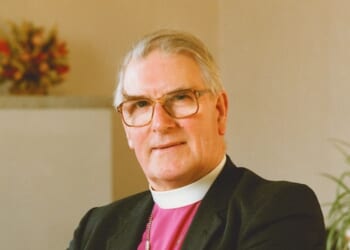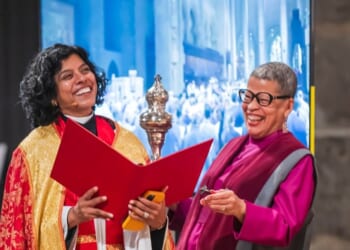LAST Friday’s grand unveiling of the Bishop of London, the Rt Revd Sarah Mullally, as the next Archbishop of Canterbury, caught many by surprise. As avid Anglican number-crunchers compiled lists of the runners and riders, it was widely assumed that the Crown Nominations Commission would pick someone younger.
Since the Second World War, almost every Archbishop of Canterbury has been appointed in his fifties, and served more than a decade: Justin Welby was 57, George Carey was 55, and Rowan Willams was just 52. Bishop Mullally’s enthronement next March will coincide with her 64th birthday; so she can serve a maximum of six years before mandatory retirement.
A short term of office means a different sort of archiepiscopal posture is necessary. It immediately lowers the pressure gauge. Back in 2013, Archbishop Welby began like a whirlwind with ambitious targets. Hoping for 13 years in post, he strategised a rolling programme of root-and-branch reform across almost every area of Church of England life, from church-planting to Lambeth Palace decor. Brimming with ideas, he pushed ahead at a relentless rate, with barely a pause for breath (Comment, 22 November 2024). His achievements were considerable, but not without cost.
Archbishop Mullally will be allowed less than half that time. And less time means, ironically, less rush. There is no huge weight of expectation on her shoulders. No dramatic new initiatives are expected, no earth-shattering announcements, no exhausting global tours.
Archbishop Welby burned up the air miles like none of his predecessors, seeking almost single-handedly to hold the Anglican Communion together. But his successor will already have retired before the next Lambeth Conference. Her first significant Anglican event — the Anglican Consultative Council in Belfast, in June 2026 — will debate the Nairobi-Cairo Proposals to recalibrate the part played by Canterbury in a postcolonial world, and to inaugurate a rotating Anglican presidency. This, too, will reduce the burdensome expectations on her office.
WE NEED to stretch back half a century for a parallel appointment. The only older post-war Archbishop was Donald Coggan. Enthroned in January 1975, aged 65, he served his maximum five years. On the day that Coggan’s appointment was announced by Downing Street, he faced a barrage of hostile questions from cynical journalists at Church House, Westminster. They asked him whether, because of his advanced age, he would be merely “a caretaker Archbishop”. But Coggan embraced this as a virtue. “Splendid!” he replied. If they meant “taking care of the Church of God”, then he was “very proud to be a caretaker”.
This image of an Archbishop who takes cares resonates loudly with Bishop Mullally’s persona. Her early formation as a nurse runs through her Christian ministry like the wording on a stick of rock. Caring, tending, binding up the wounds are close to her heart. The Anglican Ordinal is built on five biblical metaphors for ministry: servant, shepherd, messenger, sentinel, and steward (as expounded in Archbishop Cottrell’s On Priesthood, (Books, 15 May 2020). It is striking that, when Bishop Mullally laid out her stall in her opening address in Canterbury Cathedral, she reached for the first two metaphors, which emphasise compassionate care: an Archbishop who washes feet; an Archbishop who shepherds the flock.
Nursing is known as “the caring profession”. How wonderful if Archbishops became famous for the same reason. Bishop Mullally herself declares that “the possibility of healing lies in acts of kindness and love.” Kindness is, perhaps, the most underrated fruit of the Holy Spirit, often absent from Anglican discourse. But, when Bishop Mullally’s character is described by those who have experienced her ministry, “caring” and “kind” are repeated refrains. Those are not the first images that spring to mind when considering former occupants of St Augustine’s Chair, no matter how glittering their archiepiscopal careers.
OF COURSE, a short time in office will not mean treading water. Bishop Mullally spent only five years as Chief Nursing Officer, advising the Blair government, when a full decade was more typical among her predecessors. She knows how to make a decisive impact with focused priorities.
Coggan invested his five years at Canterbury in helping the Church of England to move beyond Anglican navel-gazing. His “Call to the Nation” brought the Christian message in a fresh way back into the public square, urging that a healthy British society needs more than a strong economy. Five years of Anglican evangelism is never wasted.
Archbishop Welby was keen to leave a permanent legacy, determined to make his mark. But Bishop Mullally’s historic legacy will be her very person, as the first female Archbishop of Canterbury. No matter how ceaseless her energies, or how pioneering her new ideas, it is impossible to create a greater legacy.
So, she can afford a relaxed, less frenetic, approach to high office. Even if Archbishop Mullally chooses to spend her entire time in quiet meditation in Lambeth Palace gardens, her impact will be substantial. Her appointment is already an epoch-defining moment for the Church of England, and for the history of global Anglicanism.
The Revd Dr Andrew Atherstone is Professor of Modern Anglicanism in the University of Oxford, and is writing Bishop Mullally’s biography for Hodder & Stoughton.
















